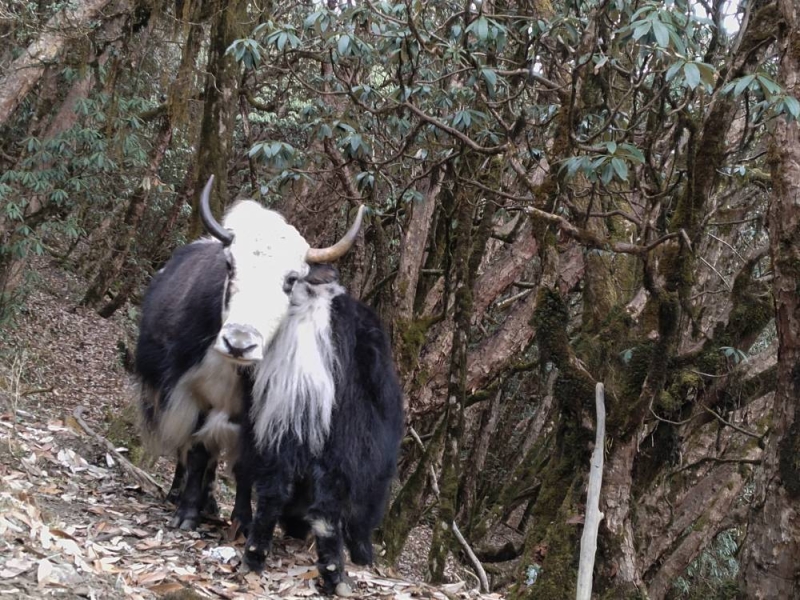At a remote location in Dolpa District, north-western Nepal, yak herders churn butter from fresh milk by hand, using age-old techniques passed down through generations. Meanwhile, in Kathmandu, one company is exploring how this traditionally crafted butter, steeped in generations of knowledge, can be transformed into a high-value product by building transparent supply chains to meet the growing demand in premium markets. This contrast between ancestral practices and modern market ambitions reveals something deeper – the untapped potential of the yak economy.
By connecting age-old practices with thoughtful quality transformation, there's a real opportunity to create lasting value for both herders and markets. Nepal's Himalayan regions are home to the remarkable yak (Bos grunniens) and a yak-cow hybrid, the chauri. These hardy bovines have been essential to high-altitude communities for centuries, providing transportation, wool, dairy, meat, and even fuel for survival.

Despite their deep cultural roots and ecological value, yaks continue to be largely overlooked in Nepal's development priorities. As mountain communities grapple with rapid climate change, rural out-migration at scale, and rising food security concerns driven by shrinking rural incomes, the yak-based economy offers promising opportunities to address the complex challenges in highland regions. Yak and chauri could help reinvigorate struggling highland economies by boosting incomes of herding communities, preserving the rich cultural heritage of Indigenous communities, and tapping into the potential of high-value markets through yak-based products such as dairy, wool, or eco-tourism services.
The yak is an icon of the Asian highlands, like reindeer in the Eurasian Arctic, camels in the Sahara, and Alpacas (domesticated members of the camel family) in the Andes. They are bioengineered for high altitudes, capable of thriving in harsh conditions, where it snows for months, and where few other livestock can survive. Their meat is rich in protein and iron, their milk contains higher fat and nutrient content than cow's milk, and their coarse wool is a natural insulation material that is gaining traction in global markets for its quality and sustainability.
The yak is a multifunctional powerhouse, playing a vital role in the lives of people living in the higher Himalayas through herding and a range of value-added products. Products derived from yak and chauri milk, like yak cheese and butter, command upscale markets with premium pricing. Yak wool is emerging as a sustainable and luxurious alternative to cashmere, a fibre obtained from cashmere goats.
Known for its durability and warmth, this wool can be processed into eco-friendly textiles with the potential to create a lasting impact in the eco-conscious fashion market. In recent times, yak-based tourism has emerged as a valuable source of livelihood for mountain herding communities. This form of experiential travel along the yak trail and ranges has been instrumental in supporting nomadic traditions, diversifying rural livelihoods, and promoting Indigenous knowledge systems.
With over 53,000 highland yaks distributed across northern Nepal, there is no shortage of raw materials to support yak-based economy through diverse value-added products. However, there is a lack of a cohesive national framework that recognises the yak economy as a strategic asset for mountain communities. Yak value chains and value addition don't need to be reinvented but they do need recognition, modernisation, support, and effective market integration.
A revitalised yak economy could tick several national priorities simultaneously, - creating green jobs for mountain youth, helping curb migration and preserving Indigenous knowledge. It could boost climate resilience as yaks have a lower environmental impact than imported livestock, since they are adaptable to highland conditions, require fewer resources, and emit less methane making them more environmentally friendly and resource efficient. It could also enhance food security in remote areas by replacing costly imports with local protein and dairy.
To realise this potential, Nepal needs to invest in yak research and breeding centres, focusing on disease surveillance and control, productivity improvement, and genetic conservation. Development of local processing units for yak dairy and fibre products, supported by branding and certification schemes is equally important. Government and donor agencies could support yak-based ecotourism through training, infrastructure, and integration into national tourism strategies and promotion.
The yak is considered the 'diamond of the Himalayan environment', a source of untapped wealth, and a bridge between tradition and innovation. As Nepal reimagines its development in response to socio-economic and climate change in the mountains, the time has come to take the yak economy seriously. This economy will prosper when mountain pastoralists can continue their profession and when people realise the cultural, ecological and economic importance of yaks.
The Nepal government has taken a major step towards recognising yaks by declaring Baisakh 7 (April 20) as 'National Yak Day'. Yak herder networks from various districts have come together to form the Yak Chauri Farmers' Federation Nepal. Their unique campaign: 'Adopt a yak, save the Himalaya' must be scaled up to bring more investments in the mountains and particularly to yak herding communities.
Though these are positive developments, more needs to be done. We must invest in the high mountains – not just in infrastructure and subsidies, but with tailored programmes for niche livestock like the yak which have sustained these communities for generations. The yak economy is not a relic of the past, it could be the future we've been overlooking.
.
Politics

The untapped potential of the yak economy

At a remote location in Dolpa District, north-western Nepal, yak herders churn butter from fresh milk by hand, using age-old techniques passed down through generations. Meanwhile,...















